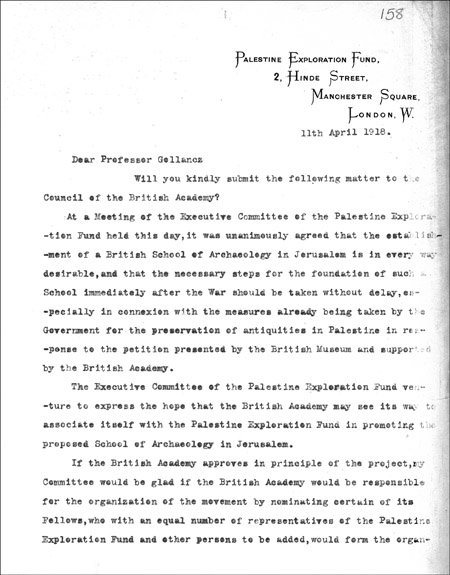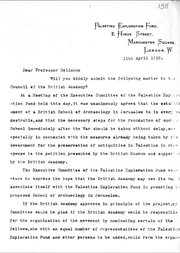Published in British Academy Review, No. 33 (Summer 2018).
The print version of this article can be downloaded as a PDF file.
On 11 December 1917, the British General Sir Edmund Allenby formally entered Jerusalem following its capture from Turkish forces.
On 13 December, Dr C.F. Burney delivered a public lecture at Burlington House in the British Academy’s series of Schweich Lectures on Biblical Archaeology, on the subject of ‘Israel’s Settlement in Canaan’. The ‘large audience’ joined the Academy in the idea of sending a telegram to offer Allenby and his ‘valiant army, the gallant liberators of the Holy City, profound congratulations on glorious achievement, the realisation of long cherished hopes, fraught with highest possibilities for the future of humanity. We rejoice that this historic triumph will ever be associated with British prowess, and with British ideals of freedom, liberty, and equal rights for races and creeds.’
On 20 December, Allenby telegraphed back. ‘The message of congratulation from the British Academy has been received with great pleasure by myself and the force under my command. We are proud to know that we have the approbation of those who represent the highest thought and intellect of the British Empire.’
But aside from this hearty mutual back-slapping and the expression of epic sentiments, British archaeologists were alert to the possibilities for protecting and then investigating the rich archaeological heritage of Palestine that could result from the presence of a British occupying force. On 8 February 1918 the British Academy wrote to the Secretary of State for War in support of a British Museum request that competent archaeologists be attached to the British forces. And the Academy wrote to the Foreign Secretary, Arthur Balfour (a founding Fellow of the British Academy), about the need to protect sites in Palestine that might be at risk; and more ambitiously, ‘in the event of that country being detached from the Turkish Empire and being placed under some other form of administration, it is highly desirable that provision should be made in advance for dealing with the whole question of archaeological research.’ The Academy said that, ‘as the official representative of historical, philological and philosophical studies of every kind’, it stood ready to act as ‘the most convenient channel’ for guidance to Government and for any negotiations with other appropriate academic bodies.
An invitation from the Palestine Exploration Fund
On 11 April 1918, Dr Leonard King, Chairman of the Executive Committee of the Palestine Exploration Fund (PEF), wrote to Gollancz to report that committee’s unanimous view that ‘the establishment of a British School of Archaeology in Jerusalem is in every way desirable, and that the necessary steps for the foundation of such a School immediately after the War should be taken without delay’. And it was hoped that the Academy would be willing to associate itself with such a proposal.
To get things moving, the PEF committee ‘would be glad if the British Academy would be responsible for the organization of the movement’ by setting up an organising committee. ‘And it is desired that, until the School is established, this Committee should be a British Academy Committee.’

At the meeting of the British Academy’s Council on 8 May, it was ‘Resolved that the Council approves the idea of the proposed British School of Archaeology at Jerusalem, & appoints the following Fellows to form an Organizing Committee together with an equal number of representatives of the Palestine Exploration Fund & other persons to be added, namely Sir F.G. Kenyon, President, Lord Bryce, Prof. Percy Gardner, Mr. D.G. Hogarth, Prof. Margoliouth, Sir George Adam Smith, Lord Reay, and Prof. I. Gollancz, Sec. of the Academy.’ And on 9 May 1918, the PEF Executive Committee drew up quite a detailed ‘Draft Scheme’ for the proposed School, for the consideration of the organising committee.
On 3 June, The Times published a notice on ‘Archaeology at Jerusalem: A Proposed British School’, announcing that the British Academy had set up the ‘Organizing Committee’, whose number now also included the Archbishop of Canterbury. The article reported that ‘The proposed school would devote itself, both by excavation and surveying, to the furtherance of Palestinian archaeology in all its branches. In addition to Hebrew and Jewish sites and antiquities, the school would include within its scope the Canaanite, Graeco-Roman, Byzantine, Arab, and Medieval periods.’ It went on: ‘An essential part of the scheme is that the school should be not only an excavating body, but also a training school for archaeologists.’ Contributions were sought to help build up an endowment fund of at least £20,000: the fund treasurer would be Robert Mond (son of Frida Mond, and cousin of Constance Schweich, both of whom had already been generous benefactors to the British Academy).
In an interview published in the Observer on 9 June 1918, Gollancz hinted that the geographical range might extend more ambitiously beyond Palestine: ‘Mesopotamia, for instance, could be served by the school at Jerusalem. Egypt, too, with the new Cairo-Jerusalem line, is now within easy distance.’ And he had no doubt that there would be plenty of potential business for the School: ‘for a right understanding of the Bible, scholars will deem irresistible the call to visit the land of the Book.’
The organising committee first met on 6 June, and Sir Frederic Kenyon – who was Director of the British Museum as well as being the Academy’s President – was appointed as Chairman. After that, for several months progress on the project was frustratingly slow. But in February 1919, the first Director of the School was appointed – Professor John Garstang of Liverpool University, described by Kenyon as ‘an experienced archaeologist and a very capable organiser’ – and he was immediately despatched to Palestine to investigate possibilities and begin negotiations with authorities. [note 1]
There would be many twists and turns before the School had a settled home in Jerusalem – but its journey had begun. [note 2]
Celebrations 1919-2019
In 1998, the British School of Archaeology in Jerusalem merged with the British Institute at Amman for Archaeology and History, to become the Council for British Research in the Levant (CBRL). To commemorate the centenary of the Jerusalem School’s foundation, throughout 2019 the CBRL will hold a series of lectures and events that focus on the historical, social and political significance of the early Mandate period in the region. They will launch this series with the Annual General Meeting lecture on 19 December 2018, entitled ‘Lawrence of Arabia: Romantic, Orientalist, and Western cultural artefact’, given by the archaeologist Neil Faulkner.
Please visit the CBRL website for further details of their centennial events: www.cbrl.org.uk
Notes
1. Thanks are owed to Felicity Cobbing of the Palestine Exploration Fund for providing access to the minutes and papers of the organising committee.
2. The early history of the British School of Archaeology in Jerusalem can be found in Shimon Gibson, ‘British Archaeological Institutions in Mandatory Palestine, 1917-1948’, Palestine Exploration Quarterly, 131 (1999), 115-143.
How are we doing? Your feedback is important to help us shape future issues of the British Academy Review.
To provide reader feedback, please visit www.britishacademy.ac.uk/british-academy-review-feedback
